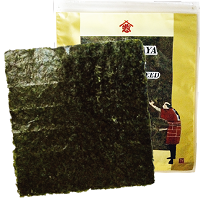Nori
 Gail Umehara / Wordsmith
Gail Umehara / Wordsmith
During her 16 years in Japan, Gail juggled raising a family with, amongst other things, working as a translation assistant, librarian, and editor. Back in Australia, she continues to work with words as an interpreter, editor and TAFE lecturer.
Nori Sushi is so popular now that most people know what nori is. If you do search for "nori" in a dictionary, it shows "laver" or "seaweed" as the definition. I used to think that "seaweed" was not a very appetizing translation, until I realized that the literal translation of 海苔 is "sea moss". At least you can still guess that it is some type of plant, while "laver" is just a mystery. In fact, nori is made from algae which grow naturally not only around the shores of Japan, China and Korea, but also around parts of the British Isles as well as Norway, Portugal, and even the coasts of America. In Wales, the seaweed is harvested and cooked for hours until it becomes a paste, sold as a local delicacy known as laverbread.
Sushi is so popular now that most people know what nori is. If you do search for "nori" in a dictionary, it shows "laver" or "seaweed" as the definition. I used to think that "seaweed" was not a very appetizing translation, until I realized that the literal translation of 海苔 is "sea moss". At least you can still guess that it is some type of plant, while "laver" is just a mystery. In fact, nori is made from algae which grow naturally not only around the shores of Japan, China and Korea, but also around parts of the British Isles as well as Norway, Portugal, and even the coasts of America. In Wales, the seaweed is harvested and cooked for hours until it becomes a paste, sold as a local delicacy known as laverbread.
In Japan, the same type of seaweed has been consumed for centuries, but not in the sheets we know now that was an 18th century innovation that saw papermaking techniques applied to processing nori, and led to the development of norimaki sushi. It turns out to be very fortunate for Japan that nori has a British relative, because it was a British scientist, Dr Kathleen Drew-Baker, who was the first person to unravel the life cycle of the algae from which nori is made. Japanese nori producers had been "farming" nori simply by guessing when the spores would be released and suspending poles in the sea for them to attach to, but nori could still only be grown in places where it already occurred naturally. In the late 1940s nori production was in crisis, mainly because runoff from heavy use of agricultural chemicals was killing off nori growth around Japan. At just the right time, in 1949, Dr Drew-Baker published the results of her research, and generously corresponded with researchers in Japan who used her results to not only revive natural growth, but make it possible to expand production through artificial seeding techniques. In a most unusual gesture, the significance of her contribution is acknowledged with a memorial statue at Sumiyoshi Shrine in Kumamoto and the Drew Festival held every year on April 14.
